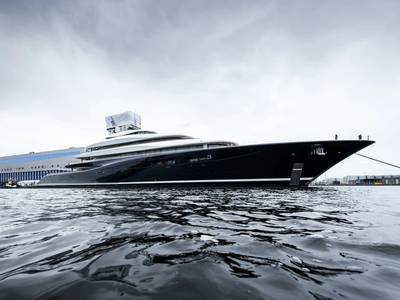Feadship Launches Fuel Cell Superyacht
Feadship's has launched a hydrogen fuel cell superyacht at its Amsterdam shipyard.
Designed by RWD and with owners’ representation by Edmiston, Feadship's approach is designed to enable the vessel to cruise between harbors or anchorages and to operate the yacht's hotel load and amenities with emission-free power from green hydrogen.
Feadship has pledged to develop net zero yachts by 2030. "The aim has been to develop a new, clean technology not just for this project, but for the world," said Jan-Bart Verkuyl, Feadship Director / CEO Royal Van Lent Shipyard. The size of the proposed yacht – 100-meters-plus – made it a good candidate to explore hydrogen use.
There were no regulations for hydrogen storage and fuel-cell systems at class, flag-state or IMO level. Seeking expert partners from allied industries, Feadship, Edmiston and Lloyd's Register developed appropriately scaled equipment, protocols and safety regulations simultaneously.
Next year, two long-route Norwegian passenger and car ferries will enter into service utilising the system pioneered with PowerCell Group for Project 821.
A key challenge has been how to store liquid hydrogen below deck at -253°C aboard a luxury yacht.
Hydrogen is light – one cubic meter of liquid hydrogen weighs 70kg compared to some 800kg per cubic meter of non-fossil diesel equivalent fuel (HVO or e-diesel). However, safely storing it on a vessel requires a double-walled cryogenic storage tank. Together, it takes eight to 10 times more space to store hydrogen than the energy equivalent in diesel fuel.
The cryogenic fuel tank that holds 92 m2 (some 4 tonnes) of hydrogen on Project 821, the 16 compact fuel cells, their switchboard connection to the DC electrical grid, and the vent stacks for the escaping water vapor adds four meters to the yacht's original specification length.
The fuel cells developed for Project 821 can also use easier-to-store methanol, a liquid fuel in ambient conditions. Steam reforms methanol into hydrogen before the electrochemical reaction in the fuel cell.
Even a yacht the size of Project 821 cannot carry enough liquid hydrogen to power a crossing, but it can impact a yacht's carbon footprint where it is largest — generating electricity to serve the hotel load.
According to the Yacht Environmental Transparency Index (YETI), 70-78% of a yacht's total energy use per year is to supply its hotel load, with heating and air conditioning making the largest demands. Supplying that electrical power via non-polluting hydrogen fuel cells has a swift and significant impact.
For longer travels or when pure hydrogen is not available, the electricity powering the 3,200kW ABB pod drives comes from MTU generators combusting HVO, a second-generation biofuel that reduces harmful emissions by 90%. The validity of powering the yacht's generators with HVO was tested and proven on the 2023 Feadship, Obsidian.
Verkuyl says fuel cells will play an important role for yachts in the years to come considering their superior efficiency, low particle emissions and low noise radiation. "We have now shown that cryogenic storage of liquified hydrogen in the interior of a superyacht is a viable solution. Future innovations on fuel cells and onboard reforming of methanol to hydrogen are on the near horizon. For Feadship, the bottom line is that the decarbonization of Feadship's upstream process such as our extensive use of aluminum produced in a more environmentally sensitive way and the production of net-zero carbon-free fuels or hydrogen carriers deserves utmost priority."
While large battery banks are becoming an accepted way to provide enough power to operate generator-free for silent nights at anchor or to cruise sensitive no-discharge marine preserve zones, Project 821 stores a mere 543kW hours of energy – compare that to Feadship's first diesel-electric hybrid, the 83.50-meter Savannah launched in 2015, which stored a megawatt of electrical energy. Project 821’s fuel cell technology can provide an entire week's worth of silent operation at anchor or navigating emission-free at 10 knots while leaving harbors or cruising in protected marine zones.
Project 821 also features an efficient waste heat recovery system for heating everything from the pool, Jacuzzi and steam room to the ambient air temperature and towel bars and floors in the guest bathrooms. Further savings in the hotel load will come from a Smart AC system linking sensors to an energy management system that automatically reduces air conditioning or heating in unoccupied guest spaces.
Guest features
Project 821 is also the largest motor yacht ever launched in The Netherlands, just edging out the recently delivered 118.00-metre Launchpad. Despite the fact the two yachts have nearly identical LOAs, Project 821 has 30% more volume.
With five decks above the waterline and two below and with a sleek mast yet to be attached, the vessel’s height is noteworthy. The owners' deck, for example, is 37 meters above water. The vessel also has the most hull openings of any Feadship to date including 14 balconies that slide out from the 'tweendeck space, five massive shell doors, and seven large opening platforms, all of which create an impressive connection to the sea. The balconies are unnoticeable when closed but slide out at the touch of a button, carrying with them their side railings or walls. When fully deployed, their floors rise to become level with the interior room.
Project 821 is designed for family use. The full owners' deck above the bridge is essentially an apartment with two bedrooms, twin bathrooms and dressing rooms, a gym, a pantry, two offices each with a fireplace, and a living room. There is a full walkaround deck, with shaded areas forward and aft and a jacuzzi.
The 19-metre beam allows wide corridors inside and gracious sidedecks outside where guests can easily walk side-by-side.
The owner accommodation extends beyond a single deck. A unique and completely private vertical corridor extends to the lower deck. This includes both a spacious staircase lined with bookshelves and display nooks and an owners' elevator. At each deck level, there are private lifestyle destinations including a coffee corner and games niche on the bridge deck, a library on the main deck, and a private dining room with a sea terrace and adjacent ensuite stateroom on the lower deck. This creates, in essence, a secluded four-level townhouse-by-the sea within the much larger yacht.





